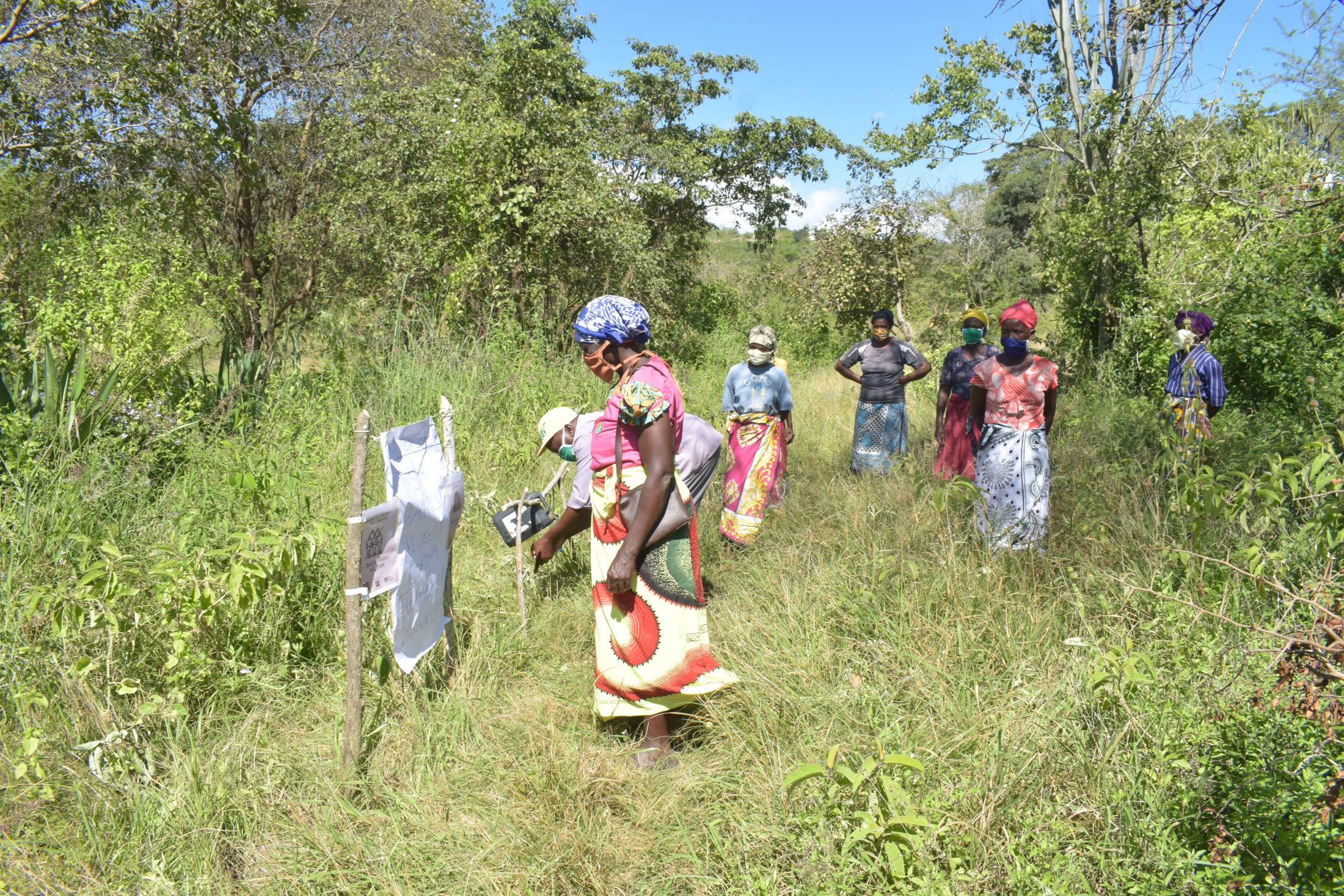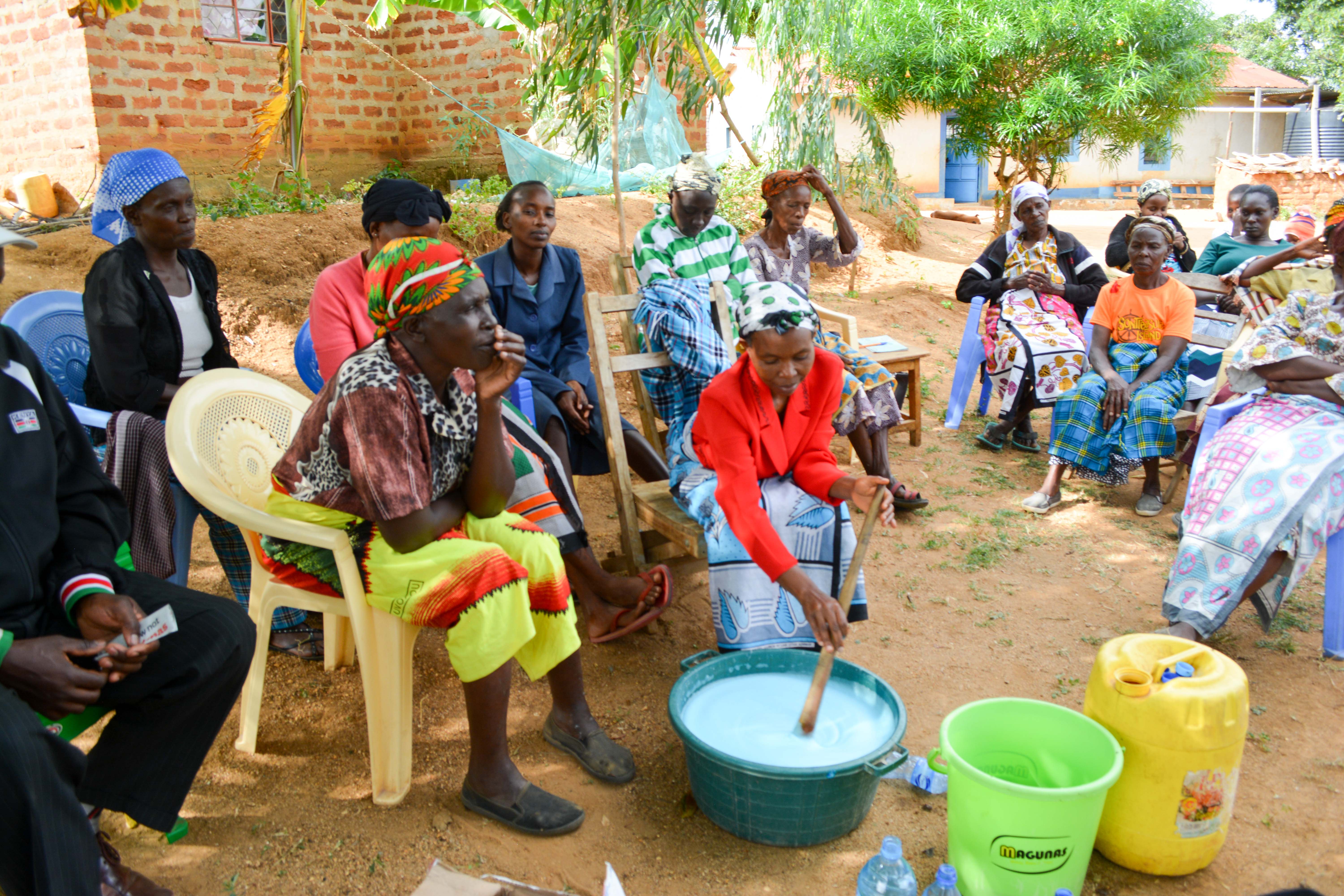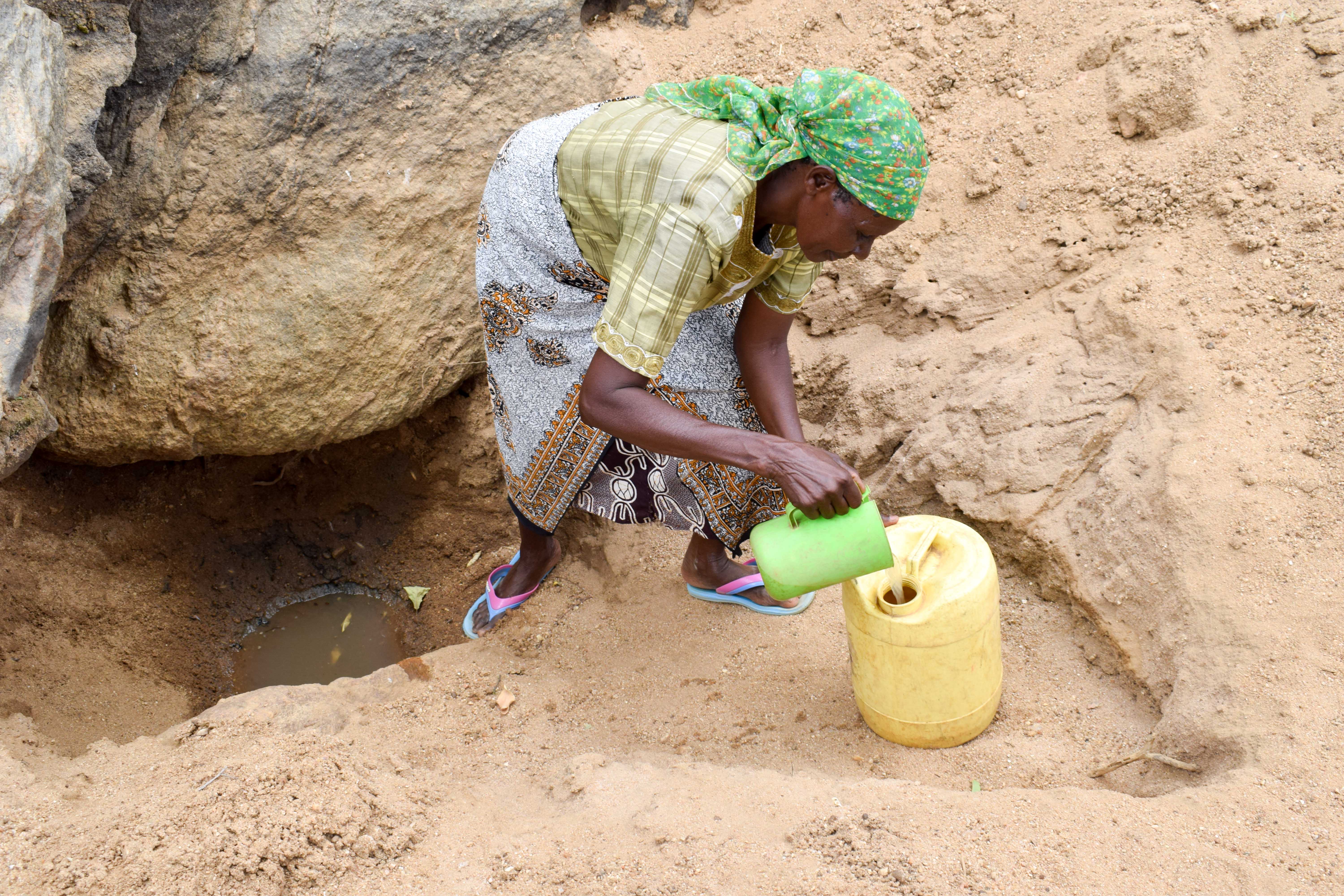Project Updates
August, 2020: Through Their Eyes: COVID-19 Chronicles with Agnes Katethya Mutheki
This post is part of a new series by The Water Project meant to highlight the perspectives and experiences of the people we serve and how the COVID-19 pandemic is impacting them. We invite you to read more of their stories here.
Our team recently visited Mbau Community to conduct a COVID-19 prevention training (read more about it below!) and monitor their water point. Shortly after, we returned to check in on the community, offer a COVID-19 refresher training, and ask how the pandemic is affecting their lives.
It was during this most recent visit that Agnes Katethya Mutheki shared her story of how the coronavirus has impacted her his life.

Field Officer Titus Mbithi met Agnes outside her home to conduct the interview. Both Titus and Agnes observed physical distancing and other precautions throughout the visit to ensure their health and safety. The following is Agnes's story, in her own words.
What is one thing that has changed in your community since the completion of the water project?
The water point has been providing us with clean water since its installation. All surrounding homesteads have unlimited access to available water resources. Again, many people have now established small kitchen gardens using the water where they are growing kales, tomatoes, and cabbages. This will help improve our eating habits.
How has having a clean water point helped you through the pandemic so far?
Having a reliable, clean water source has been of great importance to us, we are all using the available water to maintain the regular handwashing at home while also maintaining high standards of hygiene and sanitation. Having water from within is also helping towards ensuring we avoid traveling for long distances in search of water.

Since the outbreak of COVID-19 in Kenya, has fetching water changed for you because of restrictions, new rules, or your concerns about the virus?
Yeah, there was a change. Initially, I only stayed with my husband at home. Now, my grandchildren are around, which means more water is needed at home for daily use and also for maintaining the high standards of hygiene and sanitation. Fortunately, there are no major restrictions on fetching water.
How has COVID-19 impacted your family?
Covid-19 has affected my family, especially my children and grandchildren. One of my sons was locked down in town all along - even after he had lost his job. It was a nightmare for us to support him with our meager income. My daughter also came to visit us here with her three children. When the cessation of movement orders was implemented, she couldn't travel back to her home.

What other challenges are you experiencing due to the COVID-19 pandemic?
Now that my husband and I are aged, we have been dependent on our children for upkeep. This pandemic has made most of them lose their jobs, which has been a blow to us, leading to a fall in living standards.
What hygiene and sanitation steps have you taken to stop the spread of the virus?
Most of the community members have installed handwashing stations at their homes to ensure regular hand washing all the time. We are also wearing face masks while in public places as a measure to avoid the virus.
Like most governments around the world, the Kenyan government continues to set and adjust restrictions both nationally and regionally to help control the spread of the disease.

What restriction were you most excited to see lifted already?
The government lifted the movement restrictions yesterday. It is a major reprieve to my children who were locked in major towns after losing their jobs. Now they can travel home and live here with us.
What restriction are you still looking forward to being lifted?
I look forward to the lifting of the curfew restrictions and opening of schools so that life can go back to normal.
What has been the most valuable part of the COVID-19 sensitization training you received from our team?
We learned how handwashing with clean water and soap stops the spread of the virus and the importance of wearing face masks while in public places.
When asked where she receives information about COVID-19, Agnes listed the radio, word of mouth, and our team's sensitization training.

May, 2020: COVID-19 Prevention Training Update at Mbau Community
Our teams are working on the frontlines of the COVID-19 pandemic. Join us in our fight against the virus while maintaining access to clean, reliable water.

We are carrying out awareness and prevention trainings on the virus in every community we serve. Very often, our teams are the first (and only) to bring news and information of the virus to rural communities like Mbau, Kenya.
We trained community members on the symptoms, transmission routes, and prevention of COVID-19.
Due to public gathering concerns, we worked with trusted community leaders to gather a select group of community members who would then relay the information learned to the rest of their family and friends.

We covered essential hygiene lessons:
- Demonstrations on how to build a simple handwashing station
- Proper handwashing technique
- The importance of using soap and clean water for handwashing
- Cleaning and disinfecting commonly touched surfaces including at the water point.

We covered COVID-19-specific guidance in line with national and international standards:
- Information on the symptoms and transmission routes of COVID-19
- What social distancing is and how to practice it
- How to cough into an elbow
- Alternative ways to greet people without handshakes, fist bumps, etc.
- How to make and properly wear a facemask.
During training, we installed a new handwashing station with soap near the community’s water point.

Due to the rampant spread of misinformation about COVID-19, we also dedicated time to a question and answer session to help debunk rumors about the disease and provide extra information where needed.
Water access, sanitation, and hygiene are at the crux of disease prevention. You can directly support our work on the frontlines of COVID-19 prevention in all of the communities we serve while maintaining their access to safe, clean, and reliable water.

October, 2019: Giving Update: Mbau Community
A year ago, your generous donation helped Mbau Community in Kenya access clean water.
There’s an incredible community of monthly donors who have come alongside you in supporting clean water in Mbau Community. Month after month, their giving supports ongoing sustainability programs that help this community maintain access to safe, reliable water. Read more…

September, 2018: Mbau Community Sand Dam Complete
Mbau Community, Kenya now has a new source of water thanks to your donation. A new dam was constructed on the riverbed, which will build up sand to raise the water table and naturally filter water. Community members also attended hygiene and sanitation training, and plan to share what they learned with their families and neighbors.
New Knowledge
Hygiene and sanitation training was planned and organized by the Area Field Officer, Bendetta Makau, who communicated with the community members and settled on a date when Instructor Veronica Matolo could conduct sessions.
Attendance stood at 23, which was a good turnout for this important community activity. The presence of the Mbau Village Administrator demonstrated the importance of training. The group met at a homestead, arranging seats outside under trees. The weather was calm and cool, creating a conducive learning environment for all.

Mapping activities and facilities around the village
One of the most effective topics had participants out walking around the community. They searched for areas where people would use the bathroom, identifying the need for proper latrines and waste disposal. They learned about how this open defecation is being spread around their environment by flies and wild animals.

After returning to the homestead, we demonstrated how investments on good hygiene and sanitation pay off; that building a latrine, handwashing station, and treating water keeps people from having to pay for reoccurring medical treatment.

People also loved learning how to make soap. This won't only be used at the household level to wash hands, dishes, and more, but will be made in large batches to sell at the local market. The benefits to health are immediate, but the participants look forward to making an income off of their soap-making knowledge, too.

"The training has been good and a challenging one because we did not know that there’s too much open defecation in our area. We promise to change our actions and behaviors through following instructions from the training. This will help reduce the money we’ve been using for treatment," shared Mrs. Kavutha Katava.

Mrs. Kavutha Katava
"From the calculations we did... we have learned that we spend a lot of money that could be used in development activities. The training method was so simple, thus allowing us to get equal knowledge that can be passed to all the community members easily. If we follow the instructions from the training, our community will be a wealthy and a healthy one."
Sand Dam
Construction of the sand dam started at a time when the area was experiencing rainfall, which interrupted the normal construction process.
The community members collected all of the local materials like rocks and sand that were required for successful completion of the dam. They also provided unskilled labor to support our artisans. The collection of the raw construction materials takes longer than the actual construction. For a super large sand dam, materials collection could take up to four months.
Siting and technical designs were drawn and presented to the Water Resources Management Authority and a survey sent to the National Environment Management Authority for approval before construction started. Once approved, we established firm bedrock at the base of the sand dam wall. In the absence of good bedrock, excavation is done up to a depth at which the technical team is satisfied that the ground is firm enough to stop seepage.
Then mortar (a mixture of sand, cement, and water) is mixed and heaped into the foundation. Rocks are heaped into the mortar once there is enough to hold. Barbed wire and twisted bar are used to reinforce the mixture. Once the foundation is complete, a skeleton of timber is built to hold the sludge and rocks up above ground level. The process is then repeated until a sufficient height, width and length are built up. The vertical timber beams are dismantled and the dam is left to cure.

As soon as it rains, the dam will begin to build up sand and store water. With this water, the surrounding landscape will become lush and fertile.
However, it could take up to three years of rain (Because sometimes it only rains once a year!) for this sand dam to reach maximum capacity. It is 32 meters long and 4.95 meters high and took 575 bags of cement to build.

Sand dam construction was undertaken simultaneously with the construction of a hand-dug well which gives community members a safe method of drawing water. As the sand dam matures and stores more sand, a huge supply of water will be available for drinking from the adjacent hand-dug well.
To see that hand-dug well, click here.
"Mbau Village is lighting up with joy after the implementation of this water project. Clean water will now be accessible to all of us without traveling for long distances, and this will improve our living standards," said Mrs. Kavutha Katava.
"There will be improved hygiene and sanitation among community members from the unlimited availability of water with this project, the training was good and educative on ways of remaining healthy through proper cleanliness at all levels."
May, 2018: Mbau Community Sand Dam Project Underway
Unpredictable rainfall patterns can't guarantee water for communities, such as Mbau Village, all year round. Most rivers in this region are seasonal. Sand dams would, therefore, harvest rainwater where it falls and make it available to the community through the dry season, providing water for households, watering livestock, and for income generating activities.


 Sand Dam
Sand Dam
 Rehabilitation Project
Rehabilitation Project








































